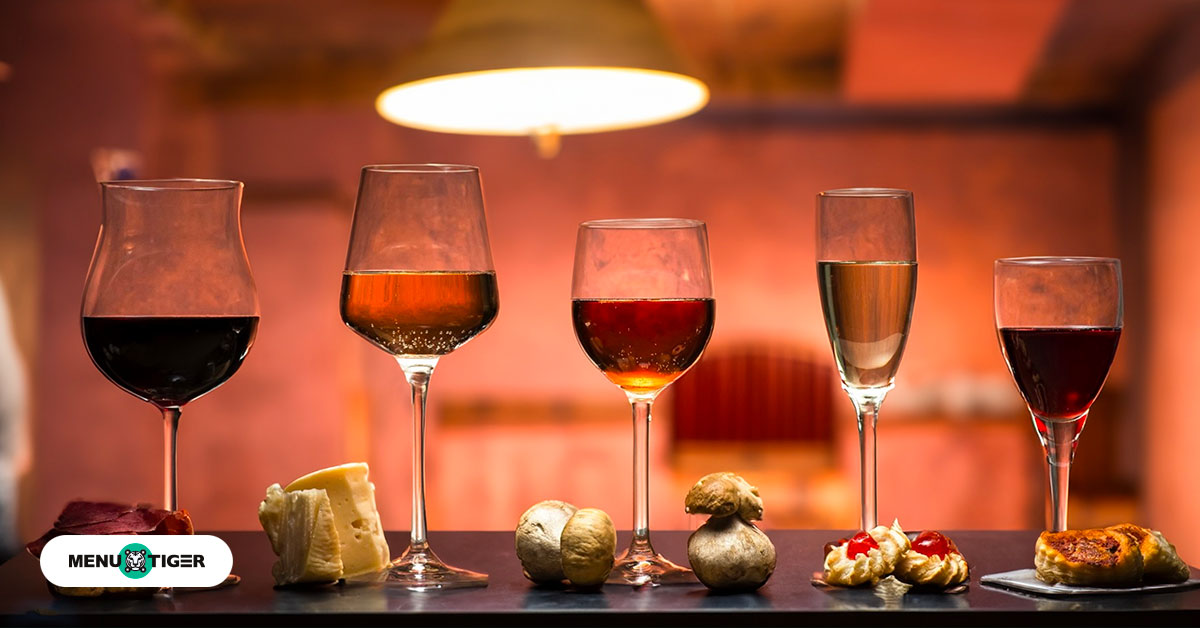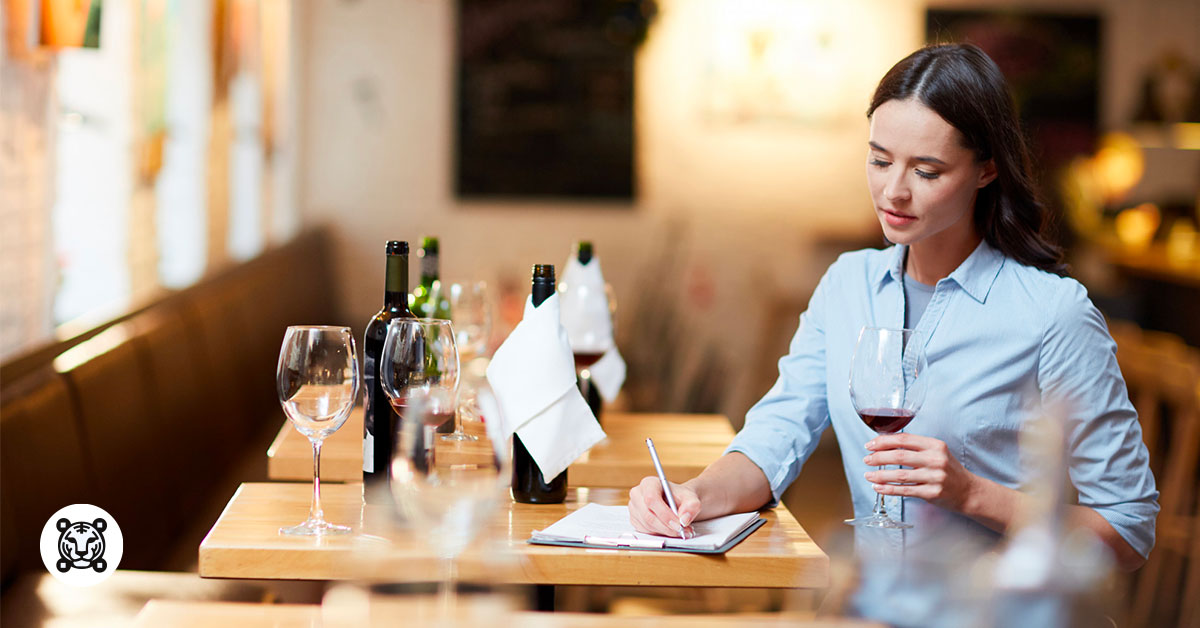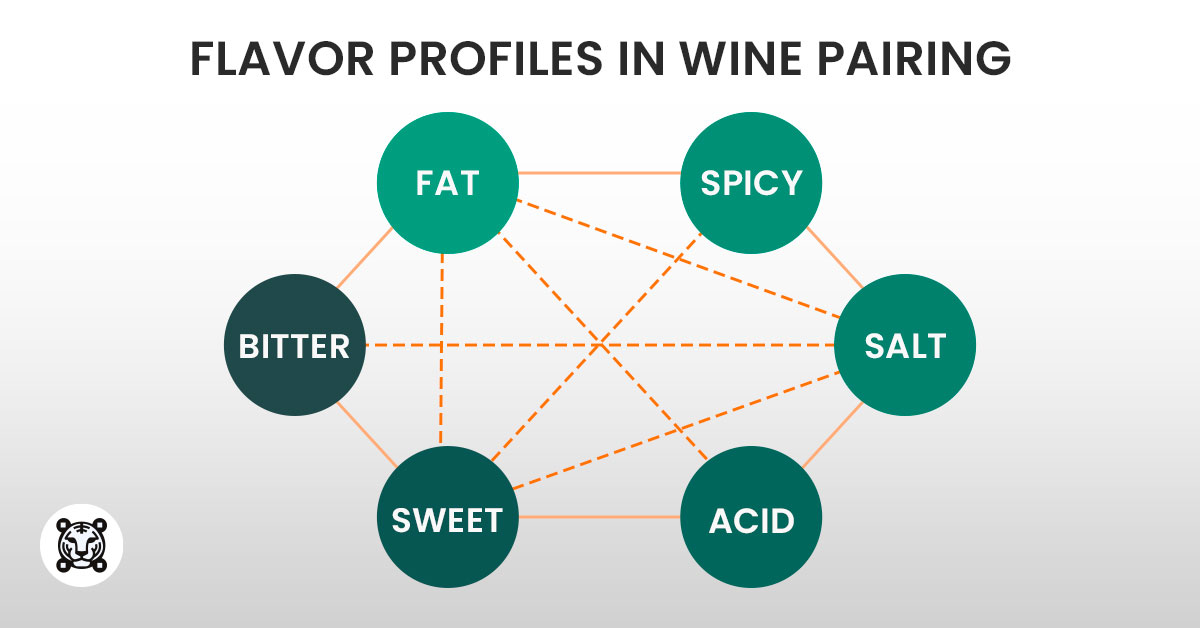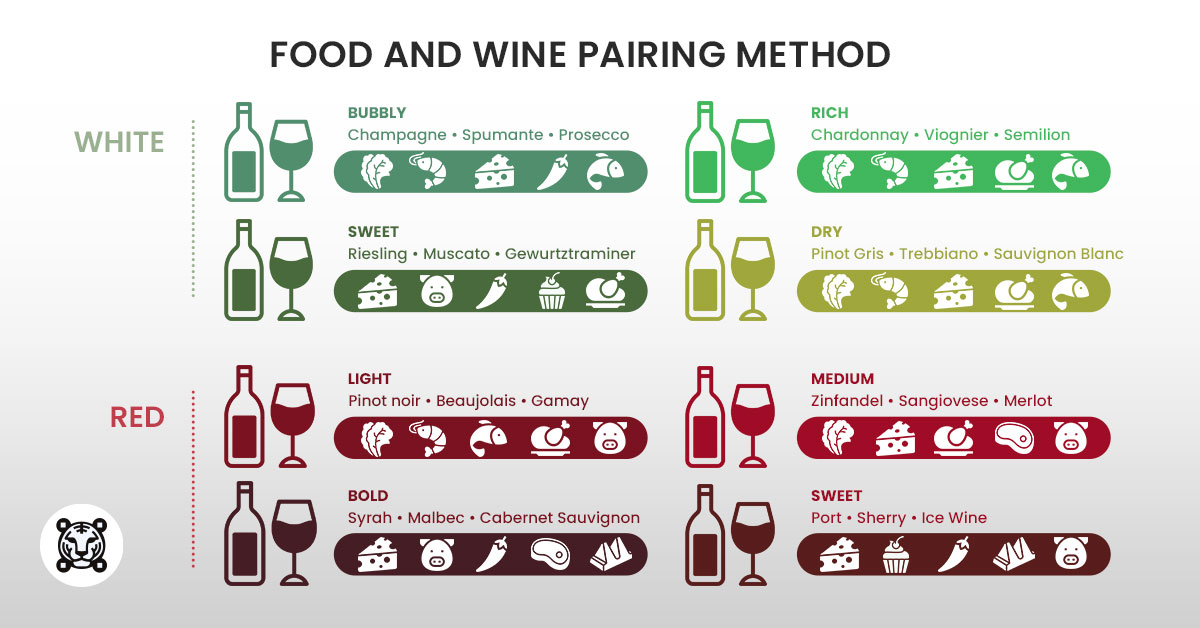
A Restaurateur’s Guide to Wine Pairing
Last Updated: June 22, 2025
Are you ready to unlock a bottle of joy and sophistication?
If you’re venturing out to offer a new set of menus by creating pairings of your dishes and drinks, it’s important to first understand what is a wine pairing menu and how it can elevate the overall dining experience.
Be equipped with knowledge on how to match them by assessing your item’s flavor intensity, choosing the best pairing method, and even considering your wine’s flavor profile.
In addition, you’ll need to think of unique ways to market your pairings, such as through a pop-up store or leveraging QR code menu technology so that your customers can interact with your offerings.
So raise your glass, and let’s discover the essentials with this beginner’s guide.
How to match food and wine: A pairing guide

A good glass of wine plus a delectable plate of food can send your guests’ taste buds into orbit.
“How will I do it?” you may wonder. It is noteworthy that choosing a wine based on its value is not always the worst approach to wine matching.
But there are general rules of thumb that can guide you to create perfect combinations.
Let’s start with these:
Evaluate the elements of your dish
Analyze the dishes you plan to serve your customers.
Consider first the primary ingredients of your food items, as these form the foundation that defines the overall taste and texture.
Following the process is understanding the cooking method to know how the food’s flavors develop and interact. Whether sauteed, roasted, or simmered—each method imbues the food with distinct characteristics.
Do not forget to assess the flavor profile of your menu items in your analysis, which involves identifying the dominant flavors, such as herbs, spices, or sauces, that contribute to its overall taste profile.
These elements are vital indicators to help you select the perfect complementary drink menu that ensures a harmonious dining experience.
Assess the intensity of flavors in the dish
Examine the depth of your food’s taste profile.
This is crucial for your wine selection, as you’ll want a wine that can complement or balance the intensity of the flavors, ranging from light and delicate to rich and bold.
When considering wine pairing menu, keep in mind to match the intensity of the wine with the intensity of the food.
For example, a light and delicate dish such as poached fish with a lemon herb sauce would pair well with a wine having a similar taste profile, such as a crisp Sauvignon Blanc or a dry Riesling.
These wines complement the gentle flavors of the dish without overwhelming them, creating a balance on the palate.
On the other hand, a rich and bold dish like a hearty beef stew or a spicy curry would call for a wine with more depth and intensity to stand out amidst robust flavors.
In this case, full-bodied red wines would be an excellent choice as their bold flavors can match the intensity of the food and provide a satisfying counterbalance.
Consider the flavor profiles in wine pairing

When it comes to pairing wine with food, there are six main flavor profiles that you need to remember. You can use this as a guide when thinking of the best pair for your meat ideas for dinner menus:
- Acidic
This flavor profile includes tart or sour tastes, often found in food like citrus fruits, vinegar, yogurt, and fermented vegetables.
In wine, acidity contributes to brightness and freshness that balance out richer and sweeter flavors.
- Fatty
Fatty flavors differ by the richness and creaminess often found in foods like butter, cheese, avocado, and fatty cuts of meat. Wine's acidity or higher levels of tannins can balance these flavors.
- Bitter
Bitterness adds complexity and depth to dishes like dark chocolate, coffee, leafy greens, and bitter herbs.
Some wines, particularly those with higher levels of tannins or aged in oak barrels, may exhibit bitterness.
- Salty
This enhances other tastes and can range from mild to strong flavors, which can be found in food like cured meat, cheeses, olives, and brined vegetables.
While this is a prominent flavor in wine, it can influence perception, especially when pairing it with salty dishes.
- Sweet
Sweetness adds a pleasant, sugary taste and can be found in fruits, desserts, honey, and some sauces. This flavor in wine can vary widely, from off-dry Rieslings to intensely sweet dessert wines like Sauternes.
- Alcohol
The alcohol content in a wine contributes to its flavor profile, which provides warmth and depth. Wines with higher alcohol content may have a more pronounced presence on the palate and can add richness and complexity to the overall tasting experience.
You can combine any profile with another to make fantastic combos. For example, you can try pairing a tannic wine with sweet food items or cutting through fatty dishes.
Tannins are compounds that primarily occur in plants, bark, and leaves and cause your tongue a dry and rubbing sensation.
Wine tannins are produced from grape skins, stems, and seeds.
Choose a pairing method

Choosing the pairing method is essential for you to be guided in selecting the right wine to enhance the flavors of the food served.
Here are two methods of pairing wine and food to improve your bottle service:
- Complementing method
This method operates on the principle that flavors enhance each other. When using this, find a wine with similar flavor characteristics to a dish, amplifying the overall taste.
Let’s consider pairing a rich and buttery Chardonnay—a versatile white wine grape—with a creamy lobster bisque or chicken alfredo. Both the wine and the dish exhibit creamy and buttery textures, making them complementary in flavor profile.
- Contrasting method
The approach of this method is to match wine with dishes that have opposite flavors to create balance on the palate.
Unlike the complementing method, contrasting pairings aim to make dynamic flavor interactions that stimulate the palate and add complexity to your customers’ dining experience.
For example, you can pair an acidic white wine with a dish like seared scallops with a creamy sauce. With this pairing, the bright acidity and refreshing qualities of the white wine contrast with the rich and creamy texture of the food.
Select the wine
Selecting the right wine involves considering several factors, such as the characteristics of the dish, your preferred pairing approach, and the wine’s own attributes.
To help you with it, here are the types of wines you could choose from:
- Red wine
This type is made from dark-colored grape varieties and typically has a deep red, purple, or garnet color.
It can range in flavor from light and fruity to bold and robust, depending on factors such as grape variety, winemaking techniques, and aging.
Common red wine varieties include Cabernet Sauvignon, Merlot, Pinot Noir, Syrah, and Zinfandel.
- White wine
This is made from green or yellowish grapes with minimal skin contact during fermentation, resulting in a pale yellow or straw-like color.
It often exhibits crisp acidity and flavors ranging from light and floral to rich and buttery. Some of the popular white wines are Chardonnay, Sauvignon Blanc, Reisling, and Pinot Grigio.
- Rosé Wine
It is made from red grapes with limited skin contact, which results in a pink or salmon-colored wine.
It can vary in flavor from dry and crisp to sweet and fruity, with notes of red berries, citrus, and flowers.
- Dessert wine
This is typically sweeter and more concentrated than table wine, with flavors ranging from honey and dried fruits to caramel and chocolate.
It pairs well with desserts and is often served in smaller quantities due to its richness.
- Fortified wine
It’s a wine whose flavor is strengthened with additional alcohol, typically brandy or neutral spirits.
This process increases the alcohol content and creates a richer, more complex flavor profile.
Consider sauce and seasonings
Pay attention to any sauces, seasonings, or accompaniments served with the dish.
These elements can significantly influence the pairing, adding to the depth and complexity of the dish that can enhance its overall flavor profile. Also, these affect the texture of your food, making them creamy or crunchy.
So, choose a wine that complements or balances their flavors and avoid the overpowering tastes of your pairings.
Think about the texture
Make sure that you consider the texture of both the food and the wine.
This is essential in the pairing process since the texture of a dish, whether creamy, crispy, or velvety, can significantly impact how it interacts with wine on the palate.
Similarly, the texture of the wine, whether it’s light and crisp or full-bodied and silky, can also affect how it complements the texture of the food.
For example, a creamy dish may pair well with a rich, full-bodied wine. While a light, crisp wine can complement a dish with a more delicate texture.
Matching dishes and wines with complementary textures ensures that they enhance each other’s flavors.
Experiment and taste
Don’t be afraid to experiment with different pairings, and trust your palate to guide you.
Taste the wine alongside the food to see how they interact, and make adjustments to achieve the perfect balance of flavors.
Evaluate your combos with the QR code menu
Take a moment to evaluate the pairing and think about how well the wine and food complement each other.
Pay attention to how the flavors combine on your palate and whether the pairing enhances the overall taste.
To help you in your decision-making process, you can add these pairings to your QR code menu and let your regular customers order them.
Make sure to encourage them to leave their reviews. The data you’ll get from their feedback can guide you in improving these combinations.
Adjust food and wine pairs as needed
If the pairings aren’t quite right, make adjustments.
Try different wines or tweak dishes slightly to achieve a better balance of flavors.
Remember, pairing wine is as much an art as a science, so trust your instincts and have fun exploring new combinations.
5 common mistakes to avoid in food and wine pairing
Now that you’ve fully equipped yourself with the information needed in the process of matching the right wine and dish, we’re going to look into things that you should avoid when doing so.
Here is a list of common mistakes you’ll need to pay attention to:
Sticking too strictly to rules
Traditional pairings can be useful, but sticking too much to them can stifle your creativity and exploration.
Don’t be afraid to think outside the box and try unconventional ways. Remember, some of the most exciting and memorable combinations come from experimentation and pushing boundaries.
Disregarding the food’s dominant flavor in wine pairing
This is one of the common mistakes that most wine bars and romantic restaurants make.
Focusing solely on the main ingredient without considering the accompanying sauces, spices, or cooking methods can lead to mismatched pairings.
To avoid this, analyze your food items comprehensively and be attentive to all their components and flavors.
Neglecting wine acidity
Ignoring the acidity level of both wine and the food is another frequent error.
Acidity in wine helps cleanse the palate and balance rich or fatty food. For instance, pairing a high-acid white wine with a creamy pasta dish can create a refreshing contrast.
Just be sure to examine the acidity of both elements when making pairings.
Overlooking wine intensity
Matching the intensity of the wine with the intensity of the dish is crucial for a harmonious pairing.
A light-bodied wine may be overwhelmed by a heavily spiced dish, while a full-bodied wine could overpower a delicate seafood menu.
So, aim for balance by matching wines with the same intensity in food.
Ignoring personal preferences
Another mistake is disregarding personal preferences when making pairings.
While guidelines can be helpful, everyone’s taste is unique. That’s why you don’t hesitate to experiment with different flavors and trust your palate.
What works for one person may not work for another, so cater to individual preferences when making selections.

9 wine and food pairing examples you’ll surely love
Here are a few pairing examples you can add to your Valentines menu, Christmas, and other holiday promotions:
Grilled salmon with lemon herb butter and Chardonnay
The buttery richness of Chardonnay, a type of white wine grape variety, complements the succulent texture of grilled salmon, while its citrus and herbaceous notes harmonize with the lemon herb butter.
Caprese salad with fresh mozzarella, tomato, and basil paired with Sauvignon Blanc
The crisp acidity and herbaceous flavors of Sauvignon Blanc match the bright, fresh flavor of the tomatoes, basil, and creamy mozzarella in this classic Italian salad.
Spicy shrimp tacos with mango salsa paired with Riesling
The slight sweetness and refreshing acidity of this wine provide a perfect contrast to the sky shrimp and tropical sweetness of the mango salsa, creating a balanced and vibrant pairing.
Beef tenderloin with mushroom demi-glace paired with Cabernet Sauvignon
The bold tannins and rich fruit flavors of Cabernet Sauvignon suit the hearty beef tenderloin, while its earthy notes harmonize with the umami flavors of the mushroom demi-glace.
Roast chicken herbed pan gravy with Pinot Noir
The light-bodied nature and bright acidity of Pinot Noir harmonize with the tender and juicy roast chicken, and its red fruit flavors and earthy undertones enhance the savory herb taste in the gravy.
Lobster Risotto with Saffron and Viognier
The aromatic floral notes and lush texture of Viognier go with the delicate sweetness of the lobster and the exotic flavors of saffron in this luxurious dish.
Grilled vegetable platter with balsamic glaze with Rosé
The bright acidity and fruity flavors of this wine contradict the smoky grilled vegetables and tangy sweetness of the balsamic, creating a harmonious and summery vibe.
Dark chocolate flourless cake paired with Tawny Port
The rich, nutty flavor and velvety texture of Tawny Port accompany the intense dark chocolate and decadent sweetness of the cake, creating a luxurious and indulgent dessert.
How to effectively market your wine and food pairing using a QR code menu: 7 strategic tips
Suppose you already have the list of pairings you're going to offer to your customers. Now, you need to strategically plan out how you are going to market them, especially when these are new menu items you’re offering.
One effective way you can go about it is to leverage the use of technology through QR codes.
Here’s how you will do it:
Curate a well-designed menu
Design a visually appealing virtual menu that showcases your wine and food pairings in an organized and easy-to-navigate format.
Use high-quality images and descriptive text to highlight the flavors and ingredients of each pair.
Include wine recommendations
Provide specific wine recommendations for each food item on your menu, emphasizing how each wine enhances the flavors of the dish.
Consider offering a range of wine options to cater to different taste preferences.
If you’re using interactive menu software like MENU TIGER, it would be more accessible for you to input these recommendations with its customization feature.
You can also add your recommendations on your website in the “Feature Food Section,” making it easier for your guests to access them.
Offer pairing suggestions
Create suggested wine and food combos to help customers in their decision-making process.
You highlight popular or chef-recommended pairings, as well as seasonal or special offerings.
All you need to do is learn how to customize a menu QR code which you don't have to worry about if you use a user-friendly digital software like MENU TIGER.
Educate customers about the art of the pairing process
Use a food menu QR code as an opportunity to educate customers about the art of wine pairing.
You can develop informative and engaging content that explains the basics of wine and food pairing, including the role of flavor profiles, textures, and regional combos.
Incorporate in the menu QR code visual aids such as charts, diagrams, or flavor wheels to help your guests understand the principles of the pairing process more intuitively.
Provide tasting notes
Include tasting notes in your paperless menu QR code for each wine on your menu, describing its aroma, flavor profile, and suggested food pairings in detail.
This information can help customers better understand the characteristics of each wine and how it complements different dishes.
Advertise special events and promotions
Use the QR code to promote special wine-tasting events, pairing dinners, or promotions at your restaurant.
You can put this on your social media platforms and other marketing materials to cater to a vast audience.
Also, with MENU TIGER software, you can generate an email list of your valued customers, which you can use to promote your upcoming events, discounts, or exclusive offers via email marketing.
Collect feedback and data
Collect valuable feedback and data from customers about their wine and food preferences.
Include a survey form using a QR code on table tents and counters where customers can share their thoughts and suggestions, helping you tailor your offerings to meet their needs better.
Serve your wine and food pairings using this interactive QR code menu software

Thinking about how you’re going to offer your wine and food combos efficiently? QR code menu software like MENU TIGER is here for you.
This advanced digital menu QR code software aims to assist you in streamlining your overall operations; from promotion to collection of feedback, it guarantees a smooth process.
Here is how it’s going to help you:
Paperless ordering process
There’s no need for you to print dozens of sheets to add your wine and food sets or list down your customers’ orders using pen and paper.
With this software, you can integrate these offerings into the digital menu. Accompanied by a QR code, your customers can automatically access and place their orders through their smartphones or tablets.
Pro tip: Display the QR codes prominently on tables or menu boards where your guests can easily spot them.
High-level customization options
One of MENU TIGER’s sought-after features is its customizable option.
Here, your customers can mix and match your menu according to their preferences, letting them have hands-on experience in experimenting with their orders.
Efficient data collection and analytics
With MENU TIGER, you can collect valuable data and insights by utilizing a survey for food and wine combos that can help you gather information about your customer behavior, preferences, and purchasing patterns.
You can use these analytics to track your menu performance and guide you to improve your offerings, refine your marketing strategies, and enhance overall experiences.
Wrapping up: Let’s start your wine pairing trip with MENU TIGER
Mastering the art of wine pairing is quite a meticulous process of exploration and discovery that offers you endless opportunities for creativity.
By understanding the principles of flavor harmony, exploring different wine styles and dishes, and diving into experimentation, you can unlock the secrets of successful pairing that upgrade the dining experience of your customers to new heights.
Alongside the well-curated combos, serving them using MENU TIGER’s QR code menu software adds an innovative touch to your wine and food pairing journey.
FAQs
Chevy
Before joining MENU TIGER's Content Team, Chevy has been dabbling in literary arts for five years, specifically creative writing in a theatre company. She loves exploring her creativity through painting, photography, and contemporary dancing.


